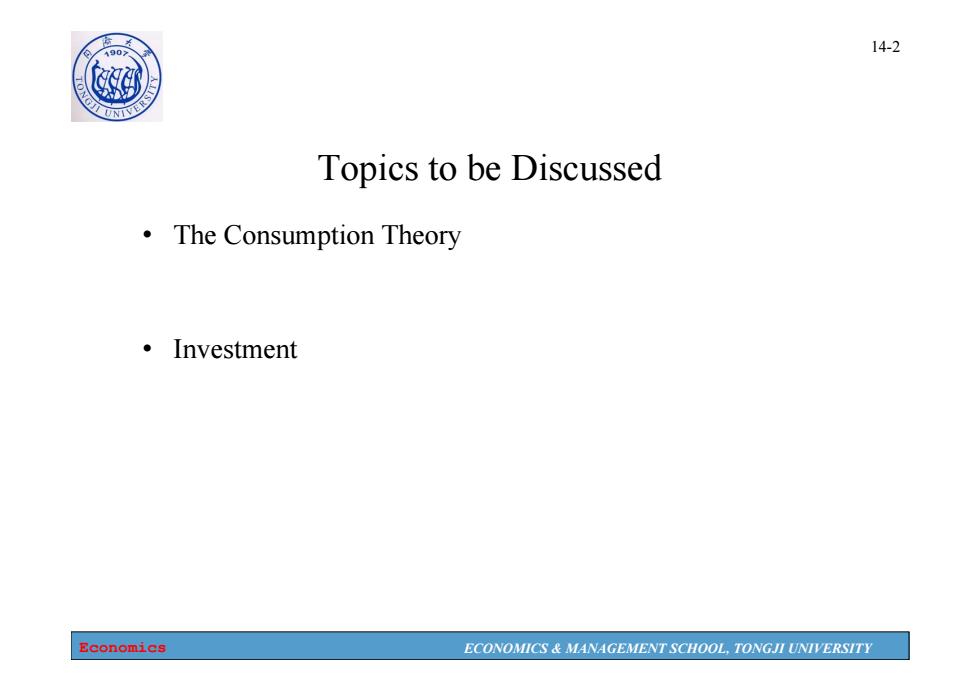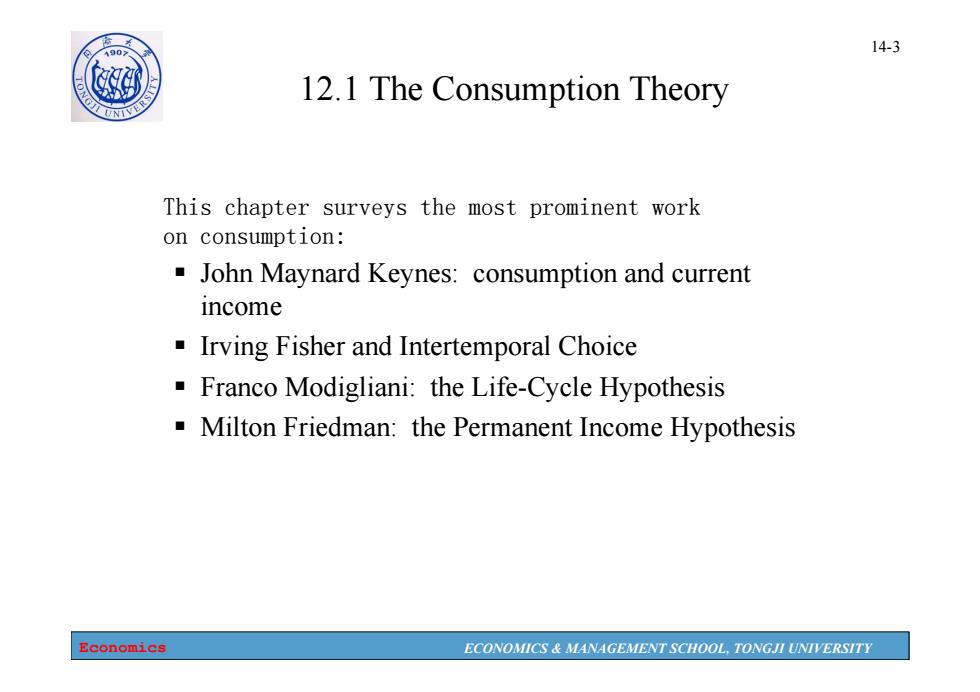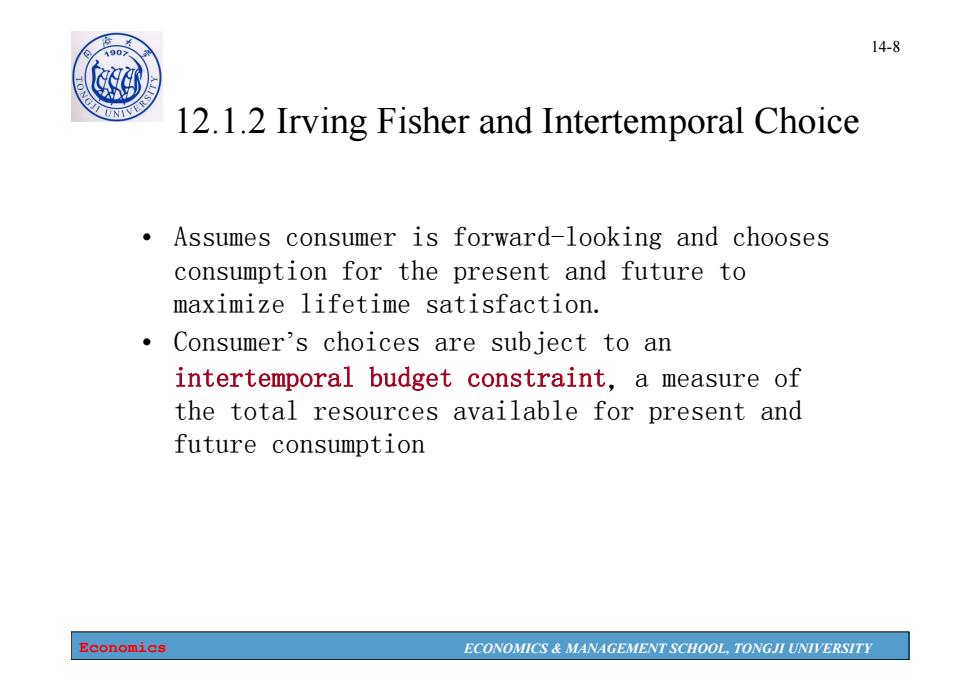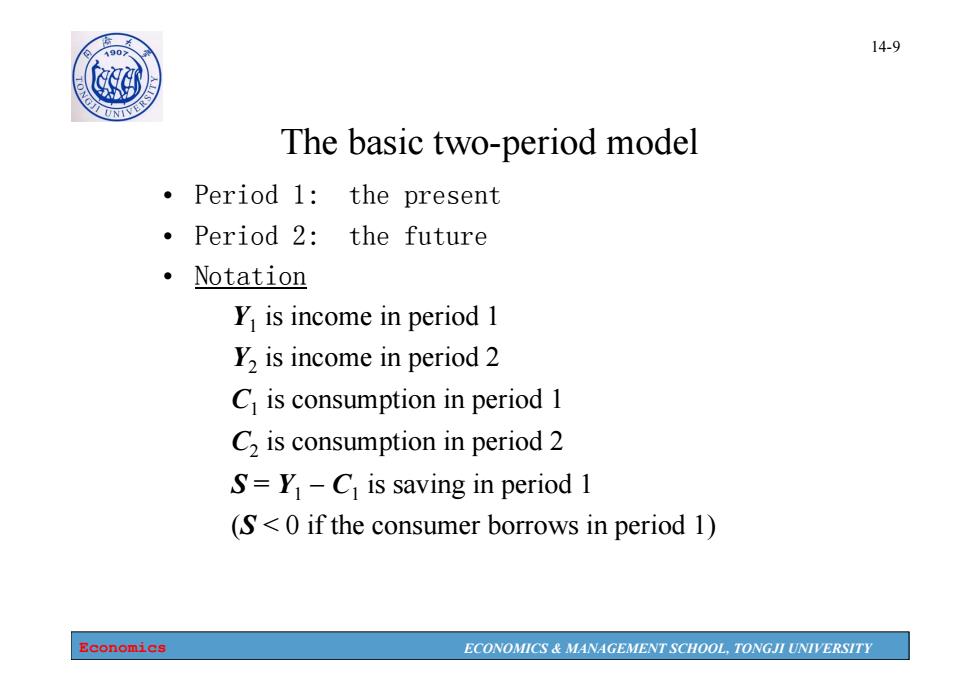
0 Ch12-1 Consumption and Investment Economics ECONOMICS MANAGEMENT SCHOOL,TONGJI UNIVERSITY
Economics ECONOMICS & MANAGEMENT SCHOOL, TONGJI UNIVERSITY Ch12-1 Consumption and Investment

1907 14-2 3树 Topics to be Discussed The Consumption Theory ·Investment Economics ECONOMICS MANAGEMENT SCHOOL,TONGJI UNIVERSITY
Economics ECONOMICS & MANAGEMENT SCHOOL, TONGJI UNIVERSITY 14-2 Topics to be Discussed • The Consumption Theory • Investment

14-3 0 12.1 The Consumption Theory This chapter surveys the most prominent work on consumption: John Maynard Keynes:consumption and current income Irving Fisher and Intertemporal Choice Franco Modigliani:the Life-Cycle Hypothesis Milton Friedman:the Permanent Income Hypothesis Economics ECONOMICS MANAGEMENT SCHOOL,TONGJI UNIVERSITY
Economics ECONOMICS & MANAGEMENT SCHOOL, TONGJI UNIVERSITY 14-3 12.1 The Consumption Theory This chapter surveys the most prominent work on consumption: John Maynard Keynes: consumption and current income Irving Fisher and Intertemporal Choice Franco Modigliani: the Life-Cycle Hypothesis Milton Friedman: the Permanent Income Hypothesis

190 14-4 12.1.1 Keynes's Conjectures 1.0<MPC<1 2.APC falls as income rises where APC average propensity to consume C/Y 3.Income is the main determinant of consumption. Economics ECONOMICS MANAGEMENT SCHOOL,TONGJI UNIVERSITY
Economics ECONOMICS & MANAGEMENT SCHOOL, TONGJI UNIVERSITY 14-4 12.1.1 Keynes’s Conjectures 1. 0 < MPC < 1 2. APC falls as income rises where APC = average propensity to consume = C/Y 3. Income is the main determinant of consumption

14-5 Problems for the Keynesian Consumption Function Based on the Keynesian consumption function, economists predicted that c would grow more slowly than r over time. This prediction did not come true: As incomes grew,the APC did not fall, and C grew just as fast. Simon Kuznets showed that C/Y was very stable in long time series data. Economics ECONOMICS MANAGEMENT SCHOOL,TONGJI UNIVERSITY
Economics ECONOMICS & MANAGEMENT SCHOOL, TONGJI UNIVERSITY 14-5 Problems for the Keynesian Consumption Function Based on the Keynesian consumption function, economists predicted that C would grow more slowly than Y over time. This prediction did not come true: As incomes grew, the APC did not fall, and C grew just as fast. Simon Kuznets showed that C/Y was very stable in long time series data

1907 14-6 APS(1869-1938) YEAR APS YEAR APS 1869-1878 0.14 1904-1913 0.13 1874-1883 0.14 1909-1918 0.13 1879-1888 0.15 1914-1923 0.11 1884-1893 016 1919-1928 011 1889-1898 015 1924-1933 06 1894-1903 0.15 1929-1938 0.1 1899-1908 0.14 Economics ECONOMICS MANAGEMENT SCHOOL,TONGJI UNIVERSITY
Economics ECONOMICS & MANAGEMENT SCHOOL, TONGJI UNIVERSITY 14-6 APS(1869---1938) 0.14 1899-1908 0.15 1929-1938 0.1 1894-1903 0.15 1924-1933 0.6 1889-1898 0.16 1919-1928 0.11 1884-1893 1879-1888 0.15 1914-1923 0.11 1874-1883 0.14 1909-1918 0.13 1869-1878 0.14 1904-1913 0.13 YEAR APS YEAR APS

14-7 A90 砂 The Consumption Puzzle Consumption function from C long time series data (constant APC) Consumption function from cross-sectional household data (falling APC) Economics ECONOMICS MANAGEMENT SCHOOL,TONGJI UNIVERSITY
Economics ECONOMICS & MANAGEMENT SCHOOL, TONGJI UNIVERSITY 14-7 The Consumption Puzzle C Y Consumption function from long time series data (constant APC ) Consumption function from cross-sectional household data (falling APC )

14-8 10 © 12.1.2 Irving Fisher and Intertemporal Choice Assumes consumer is forward-looking and chooses consumption for the present and future to maximize lifetime satisfaction. Consumer's choices are subject to an intertemporal budget constraint,a measure of the total resources available for present and future consumption Economics ECONOMICS MANAGEMENT SCHOOL,TONGJI UNIVERSITY
Economics ECONOMICS & MANAGEMENT SCHOOL, TONGJI UNIVERSITY 14-8 12.1.2 Irving Fisher and Intertemporal Choice • Assumes consumer is forward-looking and chooses consumption for the present and future to maximize lifetime satisfaction. • Consumer’s choices are subject to an intertemporal budget constraint,a measure of the total resources available for present and future consumption

14-9 The basic two-period model 。Period 1:the present ·Period2:the future Notation Y is income in period 1 Y2 is income in period 2 C is consumption in period 1 C2 is consumption in period 2 S=Y-Ci is saving in period 1 (S<0 if the consumer borrows in period 1) Economics ECONOMICS MANAGEMENT SCHOOL,TONGJI UNIVERSITY
Economics ECONOMICS & MANAGEMENT SCHOOL, TONGJI UNIVERSITY 14-9 The basic two-period model • Period 1: the present • Period 2: the future • Notation Y1 is income in period 1 Y2 is income in period 2 C1 is consumption in period 1 C2 is consumption in period 2 S = Y1 C1 is saving in period 1 (S < 0 if the consumer borrows in period 1)

190 14-10 Deriving the intertemporal budget constraint Period 2 budget constraint: C2=Y2+(1+r)S =Y2+(1+r)(Y-C) (1+r)C+C2=Y3+(1+r)Y C,+ C2 1+r =Y+ Y2 1+5 present value of present value of lifetime consumption lifetime income Economics ECONOMICS MANAGEMENT SCHOOL,TONGJI UNIVERSITY
Economics ECONOMICS & MANAGEMENT SCHOOL, TONGJI UNIVERSITY 14-10 Deriving the intertemporal budget constraint • Period 2 budget constraint: 2 2 C Y rS (1 ) 2 11 Y (1 )( ) rY C 1 22 1 (1 ) (1 ) rC C Y rY 2 2 1 1 1 1 C Y C Y r r present value of lifetime consumption present value of lifetime income